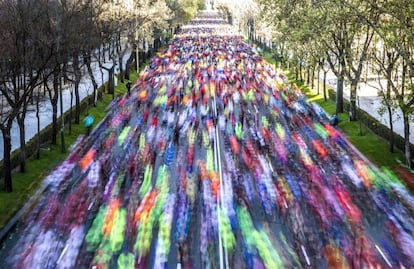Sweat shop, or how running became a global industry
Companies are cashing in on surge of interest in the sport, selling everything from tourism to treadmills
Mallorca-based Teresa Prior, 47, got into running eight years ago. In 2009, her husband bought her a heart-rate monitor and a pair of running shoes for her birthday. Since then she has become a dedicated runner and regularly enters races on the island. “What began as a means of keeping fit has turned into a lifestyle choice,” she says.

On the face of it, running is a low-budget sport. There’s no need to pay for a gym membership or buy much gear just to go for a jog around the block. And according to the latest survey carried out by Spain’s Ministry of Education, Social Policy and Sports on exercise habits, more and more Spaniards are now doing just that, with 23% running at least once a week.
Almost one in four Spaniards go running at least once a week, official figures show
The surge of interest in this form of exercise is evident from the subscriptions for the Valencia and Barcelona marathons, as well as by the 4,000 annual running events across the country. With popularity comes business: the big brand names in sport have moved in, along with tour operators, technology firms and the rehabilitation sector.
To boost tourism, some towns and regions now promote themselves on the back of a race. The events themselves are not hard to organize and infrastructure requirements are minimal. By now, all cities should be hosting a marathon. The Paris race took place several weeks ago and the Madrid Marathon on March 30. Those participating effectively complete a sightseeing tour of the city, while the aerial shots of the event offer a bird’s eye view of monuments and other attractions for viewers at home. The enthusiasm for city marathons has become so contagious that even North Korea is getting in on the action, with Pyongyang hosting its annual race this month. “This is your chance to run through the streets alongside hundreds of visitors and locals. It will be the most exciting race of your life,” says the advertisement posted online by Koryo Tours, which specializes in visits to the last bastion of hard-line communism.
In the United States alone, running generated €2.65 billion in revenue last year. “I go through four pairs of shoes a year,” says Prior. “They’re not top of the range, but they do cost €100 each. In 2016, I took part in 37 races.” Prior adds that she spends thousands of euros on trips, fees and gear. “I know it’s a lot of money, but I’m investing in fitness, happiness and a lot of friendships,” she says.
The website Idealo estimates an initial layout for the novice of €103, which covers the cost of a decent pair of running shoes, running shorts and shirt. However, once a person becomes a thrice-a-week runner, the cost could rise to €600, as gloves, wristband bracelet and thermals are added to the basic kit.
“The price of shoes ranges from €15 to €527,” says the Idealo report. If you want all the trimmings, the website suggests an outlay of €1,278, which would include a head torch for night running and a sports watch. There are also an increasing number of apps to download: virtual trainer, special nutrition in the shape of protein drinks and recovery formulas. Oh, and trips to the physiotherapist.
Almost 50% of those running the Barcelona Marathon in March were from abroad
The running boom has also changed the face of sports shops. In the center of Barcelona, the Nike store has cleared away its racks of soccer shirts and now fills its shelves exclusively with running gear. Some smaller businesses have, however, been unable to compete. “Internet sales and the arrival of the big brand stores with their heavily discounted prices meant we had to change direction and become a training club,” says Karim Portzgen, director of Prorunners, who points out that specialized shops are finding it tough to survive in the new business landscape.
“The exercise trend will continue to grow,” says Alex Rivera, manager of Indescat, the Catalan sports industry group. “This is particularly true of running, because people are increasingly worried about leading a healthier lifestyle. The customers are already here. Now all we have to do is supply them with accessories.”
An international business
Spain is a great place to run, with terrain for everything from mountain jogs to marathons, prompting strong interest from abroad. Indescat says almost half of Barcelona Marathon competitors last March were from outside Spain.
Jonathan Florido is the creator of Runnerbox, a start up that sells endurance products to athletes, as well as gift boxes for fanatics. “We asked ourselves, what we would buy someone who loves running?” says Florido, who has incorporated ‘his’ and ‘her’ kit into the range.

“Bespoke gear has great market potential, as do elite products, including exclusive running experiences,” says Rivera. “There are people who prefer to run alone and they’ll pay for that.”
As marathons increasingly professionalize, they are creating more business opportunities. ChampionChip, for example, has sold its yellow transponder chip to 40,000 Spaniards since 2000. The device can be used to keep track of the times of competitors. Last year, the company reported turnover of €750,000.
In the United States alone, running generated €2.65 billion in revenue last year
But is the interest in running for real or merely a trend that will come and go? According to one manager of a chain of specialized stores: “It’s better to have fewer quality runners than more who will drop it in a couple of years. Being a runner isn’t just about putting on a pair of running shoes and going out for a wander once a week.”
English version by Heather Galloway.
Tu suscripción se está usando en otro dispositivo
¿Quieres añadir otro usuario a tu suscripción?
Si continúas leyendo en este dispositivo, no se podrá leer en el otro.
FlechaTu suscripción se está usando en otro dispositivo y solo puedes acceder a EL PAÍS desde un dispositivo a la vez.
Si quieres compartir tu cuenta, cambia tu suscripción a la modalidad Premium, así podrás añadir otro usuario. Cada uno accederá con su propia cuenta de email, lo que os permitirá personalizar vuestra experiencia en EL PAÍS.
¿Tienes una suscripción de empresa? Accede aquí para contratar más cuentas.
En el caso de no saber quién está usando tu cuenta, te recomendamos cambiar tu contraseña aquí.
Si decides continuar compartiendo tu cuenta, este mensaje se mostrará en tu dispositivo y en el de la otra persona que está usando tu cuenta de forma indefinida, afectando a tu experiencia de lectura. Puedes consultar aquí los términos y condiciones de la suscripción digital.
More information
Archived In
Últimas noticias
Most viewed
- Why we lost the habit of sleeping in two segments and how that changed our sense of time
- Trump’s obsession with putting his name on everything is unprecedented in the United States
- Pablo Escobar’s hippos: A serious environmental problem, 40 years on
- The Florida Keys tourist paradise is besieged by immigration agents: ‘We’ve never seen anything like this’
- Charles Dubouloz, mountaineering star, retires at 36 with a farewell tour inspired by Walter Bonatti










































